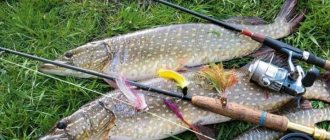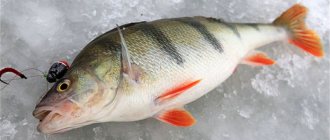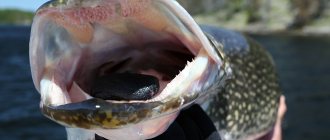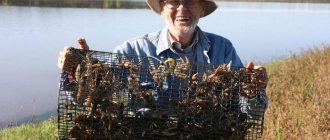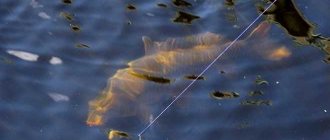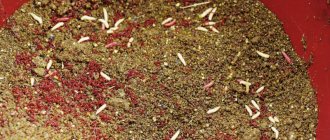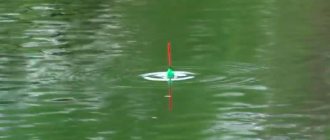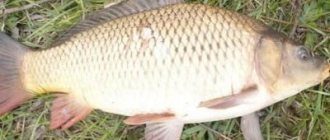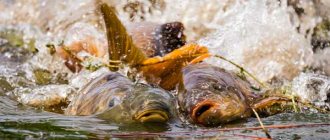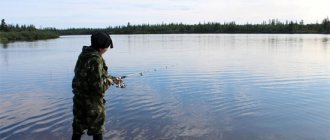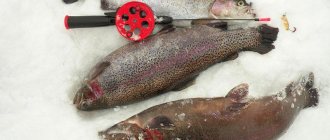A great joy for an angler is catching a trophy carp.
It is this fish that makes you feel real excitement and brings pleasure from fishing. To catch it, you need not only good and reliable gear, but also well-chosen bait and knowledge of what time you can hunt it. Carp is a domesticated species of carp, which began to be artificially bred in freshwater ponds.
There are 3 types of these individuals:
- scaly;
- mirror;
- naked carp
Their names depend on their scaly cover. The fish has a large mouth on each side of the upper jaw and antennae.
This type of fish feeds on both plant and animal foods. Carp is constantly in search of food, and it is also unpretentious in food, so it grows quite quickly. Puberty begins after 3 years of age.
Carp biting time by season
- Summer. This time of year is the most favorite for carp, since it is heat-loving and its bite improves as the water warms. Fishing in summer begins after spawning in early June and continues until early September. During the day it hides from the heat, so you should look for it at a depth of 2-5 m near underwater holes where there is cool water. He also moves into the thickets, where he calmly finds peace, food and protection from enemies.
It is better to go fishing in warm, cloudy weather, because during prolonged heat the carp eats practically nothing and waits out unfavorable weather for it. - Autumn. Fishing during this period becomes not as exciting as in summer. The water temperature drops and, accordingly, biting activity also decreases. In early autumn, it lives near thickets, snags and reeds. When the water becomes clean and transparent, the fish begins to look for places where they can hide. This type of fish prefers muddy water, where it is not visible.
Before going into hibernation, the carp begins to actively look for food for itself, so the bite during this period increases. But at the same time, the weather must correspond to his behavior.The days for successful fishing must be warm. When frost sets in, individuals of this genus most often live in pits, and if you find one, successful fishing is guaranteed.
- Winter. This is the most inappropriate period for carp fishing. It is almost impossible to attract it with bait, so it is rarely possible to return home with a trophy catch.
- Spring. Fishing begins immediately after the ice melts from the surface of the reservoir.
It should be noted that on rivers this process occurs much earlier than on closed reservoirs.After winter, carp begin to gain weight and become stronger as spawning begins soon. He actively takes any bait offered by her. When the water is still cold, its activity is not too noticeable. With each warm day, the water becomes warmer and warmer, so the carp begins to go out to the shallows, which are well warmed up by the sun's rays.
At the beginning of spring, the water is quite clear and therefore you should be very careful when catching this shy fish.
It reacts quite quickly to loud sounds on the shore, bright colors, bait and tackle. You should be quite careful.
Carp biting calendar
- Be aware that in the first weeks of spring, capture will be more likely to be accidental. Before spawning, it’s a different matter: the junction between May and April promises to be cool, since this is the time of the pre-spawning feast. Cast into shallow water, where the carp will swim to warm up and gather in mating groups.
- Summer is a time of real freedom for the feeder who wisely takes into account the weather and chooses the right bait. Stick to original plant baits, cast at night if it's been hot for weeks, and during the day if it's raining or cool, and you'll be successful.
- As autumn approaches winter, the water temperature drops, and along with it, the chances of catching a trophy fish decrease. Although at this time you can successfully catch carp, especially in September and October, if you use animal baits as much as possible. In November, success will be mainly situational.
- In early winter you shouldn’t hope for good catch, but in late winter and when fishing under ice you can, although everything is also quite random. In any case, you can cast in February, but only using non-vegetable baits.
Factors influencing good bite
A good bite of carp is influenced by quite a few factors, the main of which are:
- Atmospheric pressure and weather. It is best to go hunting for this fish on days when the atmospheric pressure is slightly lower. This could be after hot days or before rain.
- Times of Day. The greatest activity of the future catch begins at night. At this time of day, the fish begin to move a lot in search of food. You can also count on luck early in the morning or late in the evening. But, you should not deny yourself the pleasure of fishing during the day, only on the condition that the complementary food, place and fishing technique are selected correctly.
- Temperature. Carp loves warm water and weather, but without fanaticism. That is, you need to choose an average temperature, it should be neither cold nor too hot.
- Favorite habitats. Most often, carp can be found in places where there are snags. It’s good if the snag is located far from the shore. It is recommended to use heavy weights when catching it, it will not be scared, and also it will not have the desire to hide. At any time of the year, it lives in flooded river beds and ravines. It can also be successfully caught near dams. At the same time, it sinks to the bottom from 3 to 5 m, depending on the water temperature. Those fishermen who find a sandy patch where there is a spring will not be left without a catch.
Carp groundbaits and baits
It is difficult to oversatiate the owner of such a brutal appetite, and this is convenient. You can feed carp with bait containing large animal fractions at any time of the year (except winter). Use porridge as a base (boiled peas or mashed potatoes are also good alternatives) and breadcrumbs to create a cloud of turbidity. Chopped worms, maggots, bloodworms (spring and autumn) and boilies (summer) are perfect for large fractions.
There should also be no problems with delivering bait to the bait zone - use “rockets” for this. Such feeders are super-convenient because they turn over on their own when falling into the water and accurately release their contents.
The list of catchable carp baits is very wide: corn is a great choice of vegetable baits - it can generally be used in any form. Canned sweet peas will also be good, because they have a persistent taste and aroma. Even bread and potatoes will attract voracious fish.
Well, animal baits for carp - they are effective almost all year round. Make a choice in favor of a worm and you won’t go wrong; you can also give preference to bloodworms or maggots. You can put it on the hook in any way you like, up to bunches and “sandwiches”, and this is a very effective option. It’s also stupid to discount boilies - throw them away, take advantage of their attractiveness. The main thing is that the fish can swallow such bait.
Reasons for lack of bite
Despite the fact that the fish lives underwater, it still actively reacts to everything that happens both on the shore and in the water. Avid fishermen can easily determine what reasons influenced the poor bite.
What are the reasons for poor bite:
- Spawning. At this time, the fish is busy with completely different things, it has no time to look for food, so you shouldn’t expect mercy from it to get hooked.
It should also be noted that after spawning for another 2-3 weeks the fish is in a stressful state, and there will be no bite. - Atmosphere pressure. Carp does not like sudden changes, so with any deviations the fish simply forgets about its food.
- Carp can be caught in winter too
Wind. It should be moderate; its complete absence can bring failure to the fisherman. Strong wind currents also affect the bite. It is interesting to know that if there is a northeast wind near a reservoir, then there will be no bite at all.
- Times of Day. You should not try your hand at noon, in the summer heat. It is also not recommended to go fishing during the full moon.
- Excess natural food. If it is present in unlimited quantities in a reservoir, then the fisherman is unlikely to be able to attract carp with his treats.
- Poplar fluff. This is perhaps the most terrible period for fish, because after swallowing it, the fish goes to the bottom and gets sick for a long time and is not at all interested in biting.
- Tackle. They must fully correspond to the fish being hunted.
- Human factor. Any screams or noise can scare away the fish.
It should be as quiet as possible on the shore. The fisherman should wear clothes of a dull color. Also, there will be no bite for a long time in those places where electric fishing rods and explosives were used.
Basic fishing methods
- Spinning. As you know, this tackle is more suitable for catching predatory fish, but it turned out that carp does not disdain artificial baits. It will be especially useful in the fall, when the fish begin to eat. Carp eats everything, from bugs to similar fish. The spinning rod should be fairly light with a medium action. The length of the rod should not exceed 2.7 m. The fishing line should not be noticeable, so it is better to replace the fluke with 0.13 mm braid. The reel must be taken with a spinning reel with a rear clutch.
- Feeder. The most common tackle for carp fishing. In addition, it is an excellent replacement for expensive carp rods.
This type of gear is easy to use and suitable for beginner anglers.Bait for carp is sent in special feeders, which vary in shape and weight. The length of the rod should be from 3.5 to 4 m. The action is suitable for medium or fast. The reel must be inertia-free, a suitable size is 3000-4000. Only monofilament fishing line with a size of 0.25 to 0.3 mm is suitable.
- Float rod. Sometimes it is more effective than a feeder. Large carp can approach the very shore, so it is the float rod that comes to the aid of fishermen. The length of the rod should be from 4 to 6 m, depending on the casting distance. The reel should be light and inertia-free. Braided or monofilament fishing line. The float fits in different shapes with a thin tip. The hook should be of carp shape. Its size should be from 10 and below.
- Pacifier. This tackle is somewhat similar to a feeder, only the hooks on it are hidden in the bait. When the carp approaches the trap, it begins to suck up the food along with the hook, which is covered with foam and is practically invisible. After the hook is swallowed, the fish begins to move away, but a hook occurs.
- Spring. This method of carp fishing was invented when no one had ever heard of a feeder rod. In principle, this is an ordinary feeder, only it has the shape of a spring. Viscous complementary foods are placed inside it. The hooks are hidden in the treat; after the carp smells it and starts sucking out the treat, it will definitely swallow the hook.
- Makushatnik. It is a piece of pressed sunflower cake. Used for bottom tackle. It does not get wet in the water for a long time, so fishing with it always brings good results.
- Boilies. This bait is not cheap, only if you buy it in a store. You can make your own balls. For their preparation, various cereal products and flavorings are used. Used for feeder gear. The ball is put on a hook and after the fish starts to eat it, it gets hooked. The advantage of such balls is that small fish cannot swallow them. Therefore, the fisherman will only be able to catch a trophy specimen.
What to lure and feed with?
Carp is an omnivorous fish, it loves both plant and animal baits, the main thing is to know when to use which.
This is how they plant corn when fishing for carp
In the summer, baits of plant origin are more suitable:
- corn;
- peas;
- potato;
- bread, etc.
During the cold period, it begins to actively prepare for winter and gain fat, so it is better to use animal bait here:
- worm;
- maggots;
- bloodworm, etc.
Any grains, as well as flavorings and aromas are suitable for feeding. You can prepare the bait yourself from products that you can find in the kitchen, or you can buy it ready-made in a specialized store.
Spring bait
It is best to make them yourself. It should be noted that spring bait has its own characteristics.
Let's list them:
- The bait must contain an alcohol-based flavoring;
- The balls for the mixture should be rolled so that they are very tight;
- It is important not to overfeed the fish, so five small balls will be enough;
- Regular fish food will not work here.
Carp fishing techniques and tactics
For fishing to be successful, you should follow a few simple rules on fishing techniques and tactics:
- Before you start fishing, you need to study the place.
- Fish requires constant feeding, otherwise it may simply go elsewhere in search of food.
- If there are no results at a certain place, then it is better to change it.
- On the shore, there is no need to make unnecessary sounds so as not to scare away the future catch. Clothes should not be too bright. You should also carefully consider the choice of gear palette.
- It is recommended to take a lot of different baits and lures with you.
